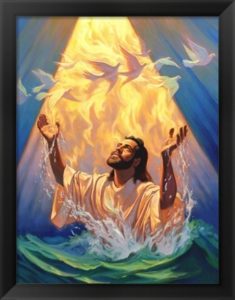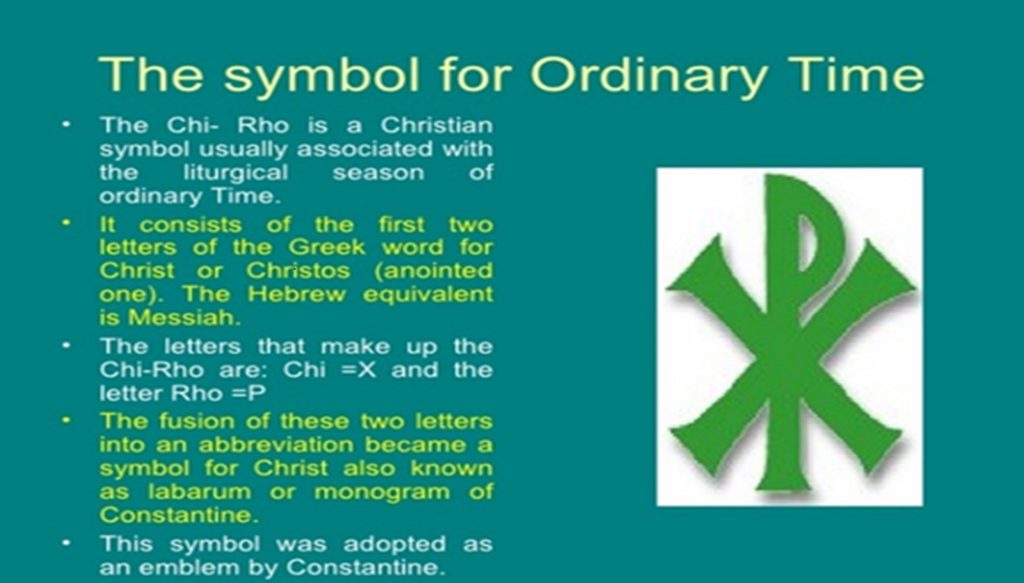Ordinary Time
Come and See!810 West Florida Ave, Melbourne, FL 32901
ORDINARY TIME
There is nothing “ordinary” about Ordinary Time! We know the Seasons of the Christian Church by the “holidays or special occasions” we celebrate: Advent, Christmas, Lent, and Easter. These Ordinary Time Sundays are known only by a number. “Ordinary” comes from the Latin word ordinalis, meaning ordinal: 1st, 2nd, 3rd etc. Ordinary Time takes up much of the church calendar. It is the time we use for learning, for growing, for exploring the Christian story, and for remembering the Church’s mission.
 The season of Ordinary Time we have just entered following the seasons of Advent, Christmas and Epiphany, begins Christ’s ministry. When He goes to the River Jordan, John the Baptizer recognizes Him and engages him in conversation. When Jesus comes up out of the baptizmal waters, we hear the words of God, “And a voice came from heaven: “You are my Son, whom I love; with you I am well pleased.” During our celebrations of Christmas and Epiphany, we rejoiced in the dawning and the arising of Light in darkness. The baptism of Christ calls the world to be witnesses to God’s true Light, Jesus. The timeless mystery of the incarnation, God in flesh, leads us forth to show and tell of Christ as God’s gift of grace and salvation for all persons. Some call this ongoing epiphany the work of Christmas.
The season of Ordinary Time we have just entered following the seasons of Advent, Christmas and Epiphany, begins Christ’s ministry. When He goes to the River Jordan, John the Baptizer recognizes Him and engages him in conversation. When Jesus comes up out of the baptizmal waters, we hear the words of God, “And a voice came from heaven: “You are my Son, whom I love; with you I am well pleased.” During our celebrations of Christmas and Epiphany, we rejoiced in the dawning and the arising of Light in darkness. The baptism of Christ calls the world to be witnesses to God’s true Light, Jesus. The timeless mystery of the incarnation, God in flesh, leads us forth to show and tell of Christ as God’s gift of grace and salvation for all persons. Some call this ongoing epiphany the work of Christmas.
This season of Ordinary Time, includes four to nine Sundays, depending on the date of Easter. It is called “ordinary” because its Sundays are given ordinal numbers (first, second, third, etc.) after the Feast of Epiphany (January 6). It stands between the two great christological cycles of Advent-Christmas- Epiphany and Lent-Easter-Pentecost. Its central theme is the calling of disciples and the early ministry of Jesus. The First Sunday focuses on the Baptism of Christ and the Last Sunday on the Transfiguration.
The Day of Pentecost (birth of the church) follows Eastertide. It begins Ordinary Time, the rest of the church year leading up to Advent.
The following is an article by Kathleen Long Bostrom/Presbyterians Today. It gives a wonderful explanation of Ordinary Time.
The breather in the church calendar after the mountaintop highs
By Kathleen Long Bostrom | Presbyterians Today
A recent cartoon in our Sunday newspaper depicted an exhausted mother, sprawled in a chair surrounded by typical birthday party chaos: torn wrapping paper, balloons, toys spread everywhere. Standing next to her, a little boy with a party hat tilted on his head asks, “When’s the next birthday?”
 I can relate to that as both the exhausted mom — ready for a break from the party planning, implementation and aftermath — and as a pastor — physically, spiritually and emotionally drained from the liturgical seasons of Advent or Lent/Holy Week/Easter. We eagerly anticipate the high holy days that frame so much of our lives, even though the preparation, expectation and effort they take leave us worn out and yes, even ready to pack up the decorations and get back in our routines. Those periods in between holidays give us time to catch our breath and return to regular life. That time in the church is known as “Ordinary Time.”
I can relate to that as both the exhausted mom — ready for a break from the party planning, implementation and aftermath — and as a pastor — physically, spiritually and emotionally drained from the liturgical seasons of Advent or Lent/Holy Week/Easter. We eagerly anticipate the high holy days that frame so much of our lives, even though the preparation, expectation and effort they take leave us worn out and yes, even ready to pack up the decorations and get back in our routines. Those periods in between holidays give us time to catch our breath and return to regular life. That time in the church is known as “Ordinary Time.”
Ordinary Time comprises all the days not marked by a specific season. It stretches on for 27 to 29 Sundays (not counting the Sundays of the Transfiguration, All Saints and the Trinity), or 33 to 34 partial weeks depending on how early or late Easter falls on the calendar and whether the year has 52 or 53 weeks.
The name “Ordinary Time” does not mean ordinary as we use the word. It comes from the word ordinal, an adjective denoting a numerical position of an object. It’s “first, second, third,” instead of “one, two, three.” Originally, all the Sundays that weren’t contained in the Advent/Christmas or Lent/Easter seasons were indicated by ordinal numbers, hence the designation. Ordinary Time is basically “counted time.”
Yet there is something about the word “ordinary” that fits. Not in the sense of boring or dull but as an “in-between” season, a time to breathe after the culmination of the celebratory days. Just as most of our days are lived between the big events, so the church year is filled with more ordinary days than holidays. The holy days are the mountaintops, whereas Ordinary Time is the slopes, valleys and flatlands. All are beautiful — and necessary.
The Scripture passages assigned to Ordinary Time set the tone. They focus on the day-to-day life of Jesus. We read what it means from a practical standpoint to follow Jesus and the social and practical implications of doing so. Scripture and sermons focus on building a community of believers, people who would be Jesus’ wounded hands, aching feet, awkward elbows and soothing voice. Jesus told stories and broke bread with a few folks at a time, not always the boisterous crowds. He listened carefully and hung out with the no-names. He fell asleep in a boat during a storm. The ordinary abides in the extra ordinary, and vice versa.
Ordinary Time is a time for us to discover that in Christ, our lives are filled with grace, forgiveness and hope. We live as people of faith, “new creations in Christ,” not just on Christmas and Easter, but also during the times in between where most of life takes P
Kathleen Long Bostrom is a retired PC(USA) minister and the author of over 50 books, most of them picture books for children.
From Presbyterians Today
 Go green. The liturgical color for Ordinary Time is green, a symbol of growth. We are more cognizant these days of the need to “go green,” to preserve our natural resources and cut back on useless waste. What is one thing you or your church can do to trim your carbon footprint in these “ordinary time” days?
Go green. The liturgical color for Ordinary Time is green, a symbol of growth. We are more cognizant these days of the need to “go green,” to preserve our natural resources and cut back on useless waste. What is one thing you or your church can do to trim your carbon footprint in these “ordinary time” days?
Honor your daily routines. Kathleen Long Bostrom says she begins her day with a cup of tea and a book, and her faithful dog snuggled by her side. “This launches me into the day in a good mindset, and if I miss it, I feel unbalanced,” she said. What “ordinary” routines give shape to your day? Write down one of your daily routines that brings you balance.
Pray without ceasing. Use life’s ordinary moments to pray. Pray at a stoplight for the other drivers around you. Pray while standing in a long line and getting impatient. Pray when sitting in a doctor’s office and the staff is way behind schedule.

